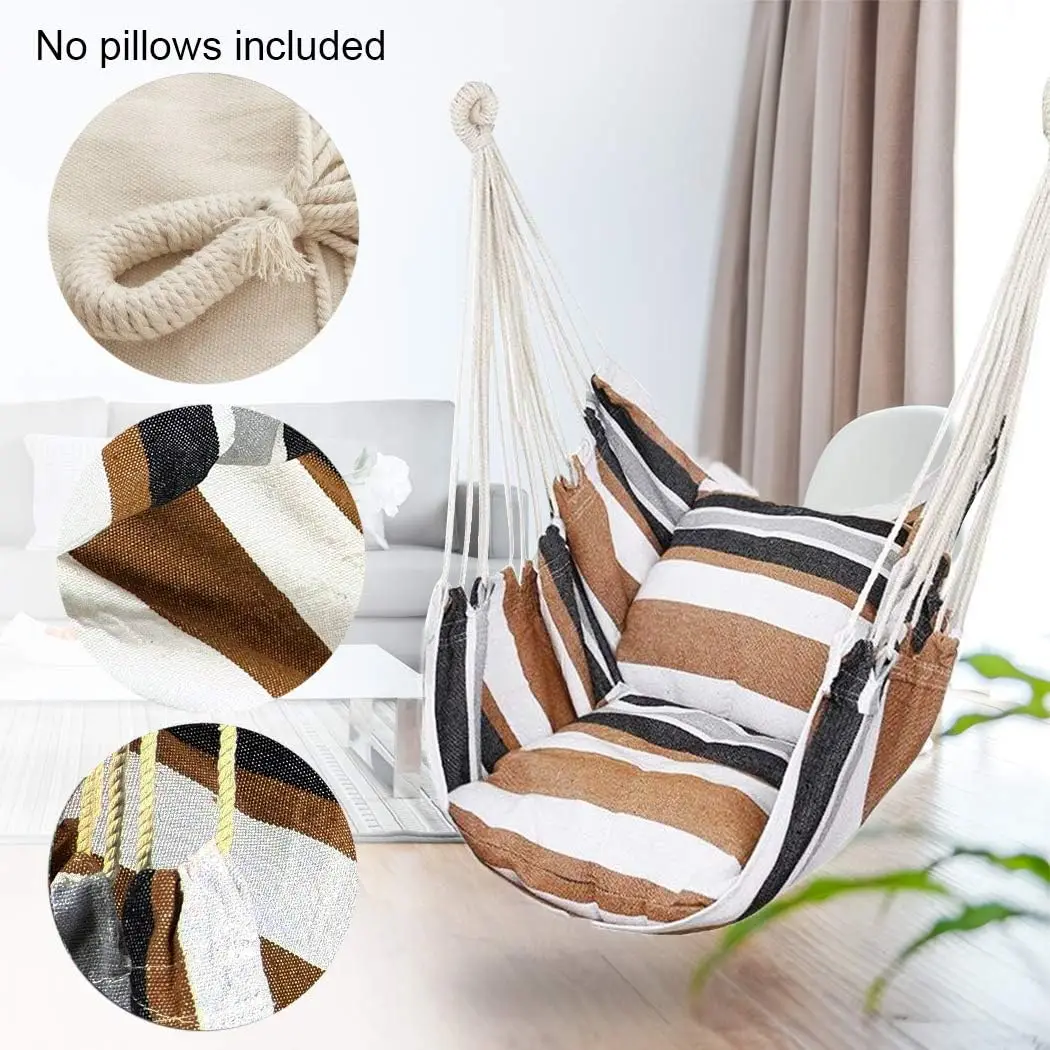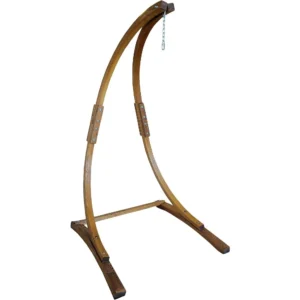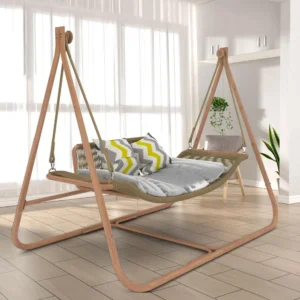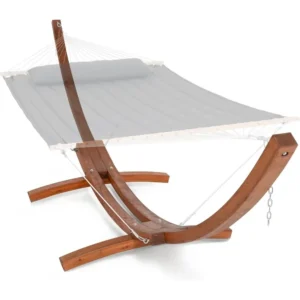Understanding Weather Risks to Your Patio Hammock Chair
Patio hammock chairs bring comfort and style to outdoor spaces, but they face constant exposure to the elements that can significantly shorten their lifespan. Weather exposure is the primary culprit behind faded fabrics, weakened frames, and deteriorating supports in outdoor furniture. Without proper protection, what should be a long-term investment can quickly become a recurring expense.
Protecting your hammock chair from weather isn’t just about maintaining its appearance—it’s about safety and value preservation. Weather-protected hammock chairs typically last 2-3 times longer than unprotected ones, representing significant savings over time. Industry data shows that proper maintenance can extend the average lifespan of outdoor furniture from 2-3 years to 7+ years.
The financial aspect is compelling—replacing a premium hammock chair every few years costs substantially more than implementing simple protection strategies. Studies from outdoor furniture manufacturers indicate that weather damage accounts for nearly 80% of all premature furniture replacement.
In this guide, you’ll discover:
– The specific weather elements that damage hammock chairs
– Which materials offer superior weather resistance
– Practical protection strategies for every season
– Maintenance routines that extend your chair’s lifespan
– Repair solutions when damage occurs
Understanding how weather affects swinging hammock chairs for patios is the first step toward protecting your investment and ensuring years of comfortable outdoor relaxation.
When looking for durability in outdoor seating, many homeowners find that quality hammock chairs with stands provide both comfort and resilience when properly maintained.
Critical Weather Elements That Damage Hammock Chairs
Weather elements work continuously to break down your hammock chair, each presenting unique challenges that require specific protection strategies. Understanding these threats helps you take targeted action to preserve your outdoor furniture.
UV Radiation Effects on Different Materials
UV radiation is perhaps the most persistent enemy of outdoor hammock chairs. This silent destroyer works daily, even when temperatures are mild and conditions seem perfect.
For fabric components:
– Untreated cotton fabrics show noticeable fading in just 3-4 months of regular sun exposure
– UV-treated synthetic fabrics typically maintain color integrity for 2+ years
– Prolonged exposure weakens fibers at a molecular level, reducing strength by up to 40%
– Even indirect UV exposure reflected from water, glass, or light-colored surfaces causes cumulative damage
The protection mechanism in UV-resistant fabrics involves special dyes and treatments that absorb or reflect harmful rays before they can break down the material structure. When selecting a hammock chair, UV resistance ratings provide a concrete measure of how long fabrics will maintain their appearance and integrity.
Moisture and Humidity Concerns
While sun damage occurs slowly, moisture can create problems almost overnight. Rain, morning dew, and high humidity levels create the perfect environment for deterioration.
The relationship between moisture and damage isn’t simple—it’s the repeated cycle of wetting and drying that causes the most harm. When fabrics remain damp for extended periods, mold and mildew can develop within 48-72 hours, especially when humidity exceeds 60%. These organisms not only create unsightly spots but also break down fabric fibers and produce allergens.
For frames and hardware, moisture initiates corrosion processes. Even small amounts of water trapped in joints or screw holes can cause rust to form on steel components. In wooden parts, moisture absorption leads to swelling, warping, and eventual splitting as the wood dries unevenly.
Different materials show varying vulnerability:
– Natural fibers like cotton absorb up to 27% of their weight in water
– Untreated metal hardware can begin oxidizing within hours of moisture exposure
– Wood can absorb moisture for days, creating hidden damage that appears later as warping
For reliable protection in wet climates, moisture-resistant hammock chair options incorporate specialized treatments and materials designed to repel water and dry quickly.
Wind Damage Prevention
While often overlooked, wind presents significant risks to hammock chairs through constant stress and sudden gusts. Hammock chairs essentially act as sails, catching wind and creating strain on attachment points and frames.
Most manufacturers recommend securing or storing hammock chairs when winds exceed 15-20 mph (24-32 km/h). At these speeds, the repeated movement and strain can weaken connections, stretch fabrics unevenly, and potentially cause tipping.
Common failure points from wind damage include:
– Frayed hanging ropes or chains
– Bent or twisted frame components
– Stretched fabric around attachment points
– Loosened hardware throughout the structure
The most effective wind protection combines proper placement, secure anchoring, and a ready storage plan for when conditions exceed safe thresholds.
Best Weather-Resistant Materials for Hammock Chairs
The foundation of weather resistance lies in selecting the right materials from the start. Premium materials may cost more initially but deliver substantially longer lifespans and better performance in challenging weather conditions.
Weather-resistant materials for hammock chairs vary significantly in durability, with quality synthetics typically lasting 5-7 years versus 1-2 years for untreated natural materials. The investment in premium materials typically pays for itself multiple times over through extended useful life.
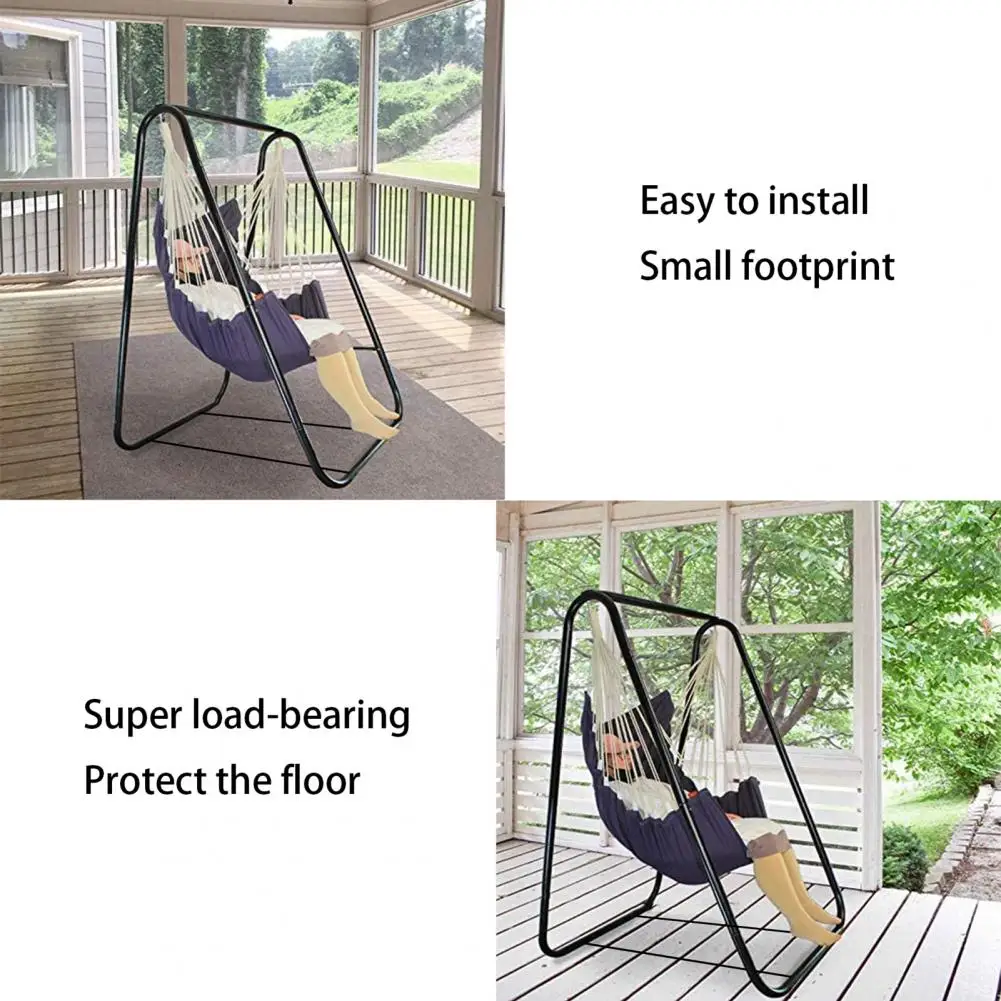
Our curated selection of swinging hammock chair sets features materials specifically chosen for their outdoor durability and weather resistance.
Superior Synthetic Fabrics for Weather Resistance
Fabric selection is perhaps the most critical decision for weather resistance, as fabric typically shows damage first and is essential to comfort.
Solution-dyed acrylic stands as the gold standard for outdoor fabric performance. Unlike regular dyed fabrics where color sits on the surface, solution-dyed fibers have color throughout each fiber, much like a carrot rather than a radish. This construction provides:
– Exceptional fade resistance (1,500+ hours of direct sunlight without significant color loss)
– UPF 30-50+ ratings for UV protection
– Natural water repellency that speeds drying
– Resistance to mildew formation
Polyester fabrics offer an excellent balance of performance and value, featuring:
– Good UV stability with proper treatments
– High strength-to-weight ratio
– Quick drying properties
– Resistance to stretching and shrinking
Olefin (polypropylene) provides outstanding moisture performance:
– Naturally hydrophobic—repels water rather than absorbing it
– Dries extremely quickly
– Lightweight yet durable
– Highly resistant to chemical damage from pool water or cleaning products
For hammock chairs that will see regular outdoor use, superior synthetic fabrics for weather resistance provide the best combination of comfort, appearance, and longevity.
Frame and Structural Materials Comparison
While fabric receives the most attention, the structural components of hammock chairs face equal weather challenges and must provide reliable support year after year.
Aluminum frames offer exceptional outdoor performance:
– Naturally resistant to rust and corrosion
– Lightweight for easy repositioning
– Available in various finishes for enhanced protection
– Requires minimal maintenance
Steel provides unmatched strength but requires additional protection:
– Higher weight capacity than other materials
– Superior stability in windy conditions
– Requires powder-coating or galvanization to prevent rust
– Heavier, making repositioning more difficult
Wood frames bring natural beauty but demand more care:
– Teak and eucalyptus contain natural oils that resist moisture
– Require seasonal sealing to maintain weather resistance
– Develop an attractive patina over time if properly maintained
– Offer a premium aesthetic other materials can’t match
Synthetic wicker/rattan balances appearance and durability:
– Mimics natural materials without their weather vulnerabilities
– UV-stabilized to prevent brittleness and color loss
– Easily cleaned with simple soap and water
– Various weave patterns affect durability and debris collection
For maximum stability and longevity in challenging environments, heavy-duty hammock sets with weather-resistant frames provide the necessary structural integrity while withstanding the elements.
Essential Protection Strategies for All Seasons
Effective weather protection requires a thoughtful combination of preventative measures and responsive care. The most successful approach involves basic year-round practices supplemented with seasonal adjustments.
Year-round protection fundamentals include:
1. Keeping hammock chairs clean and dry
2. Addressing small issues before they become major problems
3. Using appropriate covers during periods of non-use
4. Positioning chairs to minimize direct weather exposure
After unexpected weather events, taking immediate action can prevent lasting damage:
– Dry thoroughly after rain (including hidden areas where water collects)
– Remove debris that can trap moisture against surfaces
– Check and tighten hardware that may have loosened
– Inspect for any developing issues that need attention
The protection needs of hammock chairs vary significantly by climate type:
– Hot, sunny climates require emphasis on UV protection and heat management
– Humid environments demand strategies to prevent mold and mildew
– Coastal areas need additional corrosion protection against salt air
– Regions with freeze/thaw cycles require special attention to moisture control
Understanding the protection features for patio swing chairs helps you select models with built-in weather resistance and identify where additional protection may be necessary.
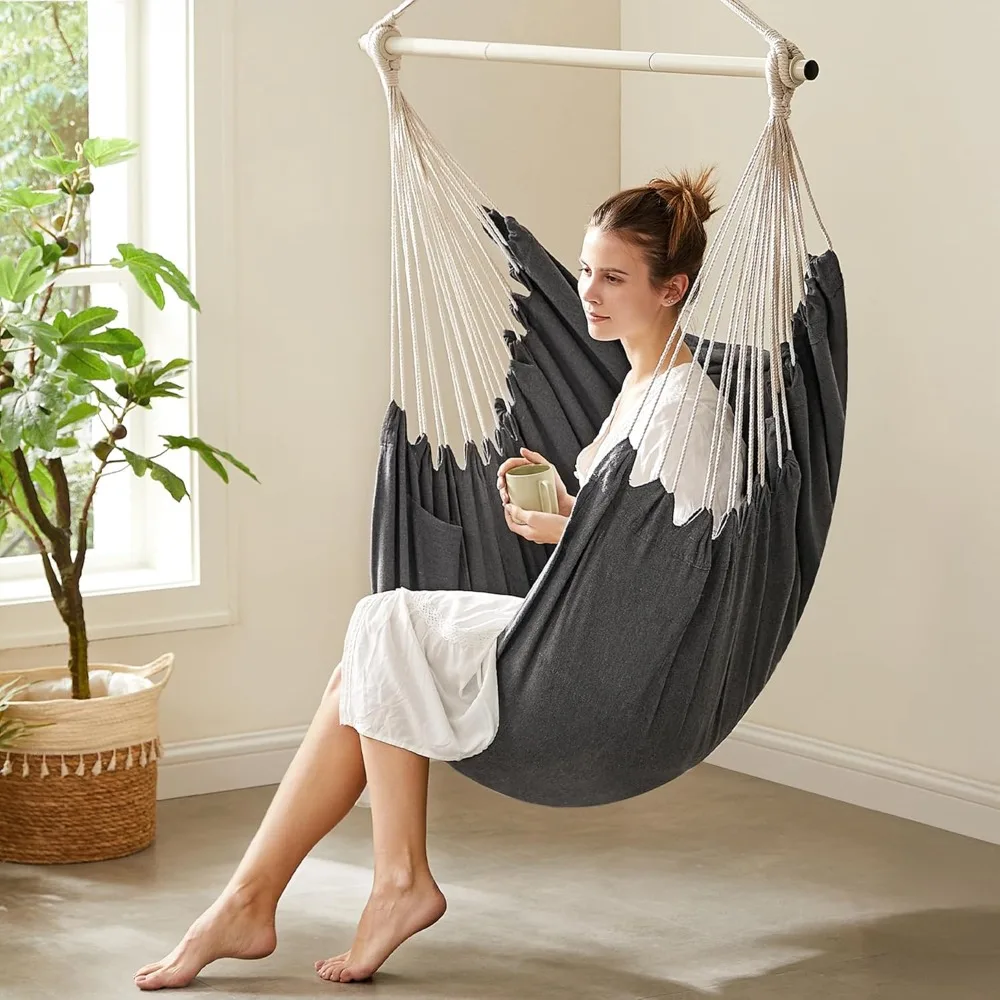
Using Protective Covers Effectively
Protective covers represent the simplest yet most effective weather protection strategy. However, not all covers provide equal protection, and improper use can sometimes create new problems.
When selecting covers, look for:
– Water resistance with breathability to prevent condensation
– UV inhibitors to prevent cover degradation
– Secure fastening systems to prevent wind displacement
– Reinforced areas where wear typically occurs
– Size appropriate for full coverage without excessive material
Proper cover use extends hammock chair life by 2-3 years on average. The key is consistency—even occasional exposure during bad weather can initiate damage processes that continue even after protection is restored.
Common covering mistakes include:
– Covering chairs while still damp, which promotes mildew
– Using non-breathable covers that trap moisture
– Failing to secure covers properly against wind
– Letting covers collect water in sagging areas
– Not removing covers occasionally to allow air circulation
Hammock sets with protective canopies offer built-in weather protection while still allowing use during mild precipitation or intense sun.
Strategic Placement and Positioning
Where you place your hammock chair significantly impacts its exposure to damaging elements. Thoughtful positioning provides passive protection that requires no additional effort after the initial setup.
Consider these placement factors:
– Track sun patterns to understand exposure throughout the day
– Identify areas with natural wind barriers
– Position at least 6 feet (1.8 meters) from sprinklers and downspouts
– Look for existing structures that provide partial coverage
– Consider seasonal sun angle changes that affect shade patterns
Rotation strategies help distribute wear evenly across the hammock chair. Just as we rotate tires on cars, periodically changing the orientation of your hammock chair ensures no single area receives excessive exposure.
Creating microclimate protection involves using nearby elements to modify the immediate environment around your hammock chair:
– Potted plants can provide strategic shade and wind buffering
– Decorative screens block prevailing winds or afternoon sun
– Pergolas with seasonal covers offer adjustable protection
– Strategic placement near moisture-absorbing materials reduces humidity
For detailed assistance with ideal setup, our guide to strategic hammock chair placement provides climate-specific recommendations.
Dark Wood Hammock Sets, Porch Swing Chair Sets
$653.82 Select options This product has multiple variants. The options may be chosen on the product pageA-Frame Stand Hammock Sets, Swinging Hammock Chair Sets
$154.62 Select options This product has multiple variants. The options may be chosen on the product pageLight Wood Hammock Sets, Swinging Hammock Chair Sets
$1,359.35 Select options This product has multiple variants. The options may be chosen on the product pageClassic Wooden Stand Hammock Sets, Heavy Duty Hammock Sets
$1,061.68 Select options This product has multiple variants. The options may be chosen on the product pageHammock Sets with Canopy, Heavy Duty Hammock Sets
$286.31 Select options This product has multiple variants. The options may be chosen on the product pageHeavy Duty Hammock Sets, Wooden Arc Stand Hammock Sets
$878.66 Select options This product has multiple variants. The options may be chosen on the product page
Seasonal Maintenance Guide for Hammock Chairs
Weather protection requires adjusting your approach throughout the year. Each season brings unique challenges that need specific attention.
Spring Maintenance
As temperatures warm, focus on:
– Deep cleaning to remove winter dust and debris
– Checking all hardware for signs of winter damage
– Reapplying fabric protectants after cleaning
– Inspecting hanging mechanisms for wear
– Repositioning for changing sun angles
Summer Protection
During peak UV and usage season:
– Implement shade strategies during intense midday sun
– Clean more frequently to remove body oils that attract dirt
– Watch for and address fading as an early warning sign
– Check for stretched fabrics that may need adjustment
– Maintain diligence with covers during thunderstorm season
Fall Preparation
As weather becomes more variable:
– Clean thoroughly before reducing usage
– Apply protection products before winter storage
– Address any summer damage before it worsens
– Tighten all hardware that may have loosened
– Begin using covers more consistently
Winter Storage or Heavy Protection
During the off-season:
– Implement full storage in severe winter climates
– Use heavy-duty covers for chairs remaining outdoors
– Elevate chairs to prevent standing in snow or water
– Remove cushions for indoor storage when possible
– Perform periodic checks during extended storage
The seasonal maintenance cycle typically requires 1-2 hours per season, with summer demanding the most frequent attention. This minimal time investment significantly extends your hammock chair’s useful life.
Cleaning Techniques for Different Materials
Proper cleaning removes substances that can accelerate deterioration while preserving protective finishes. Different materials require specific approaches for effective cleaning without causing damage.
For fabric components:
– Use mild soap solutions (1 tablespoon mild detergent per gallon of water)
– Avoid bleach on colored fabrics
– Clean with soft brushes using gentle circular motions
– Rinse thoroughly to remove all soap residue
– Allow minimum 24-hour drying time before covering or storing
For frames and structural elements:
– Wipe metal frames with appropriate cleaners (avoid abrasives on finishes)
– Clean wood with products specific to the wood type
– Use soft cloths rather than rough materials that can scratch
– Pay special attention to joints where moisture collects
– Dry thoroughly, especially in hidden recesses
Fabric hammock sets require particular attention to cleaning techniques that preserve both appearance and structural integrity of the textile components.
Weatherproofing Treatments and Products
Beyond cleaning, applying specialized treatments provides an additional protection layer against weather elements. These products create barriers that repel moisture, block UV rays, or prevent oxidation.
For fabric protection:
– Spray-on fabric guards create invisible shields against moisture and stains
– UV protectant sprays add another layer of fade resistance
– Application typically requires 3-6 month renewal
– Always apply to completely clean, dry fabrics
– Allow full curing time (24-48 hours) before exposure
For metal components:
– Rust inhibitors slow oxidation processes
– Clear protective coatings maintain appearance while adding protection
– Touch-up products address small areas of damage before spreading
– Lubricants prevent moisture from accessing moving parts
For wooden elements:
– Sealants block moisture absorption
– UV inhibiting finishes prevent graying and cracking
– Oil treatments feed wood fibers to prevent drying and splitting
– Application frequency varies by product (typically 1-4 times yearly)
Natural alternatives include:
– Beeswax mixtures for water resistance
– Plant-based oils for wood nourishment
– Vinegar solutions for mold prevention
Wooden hammock stands particularly benefit from regular application of appropriate weatherproofing treatments to maintain their structural integrity and appearance.
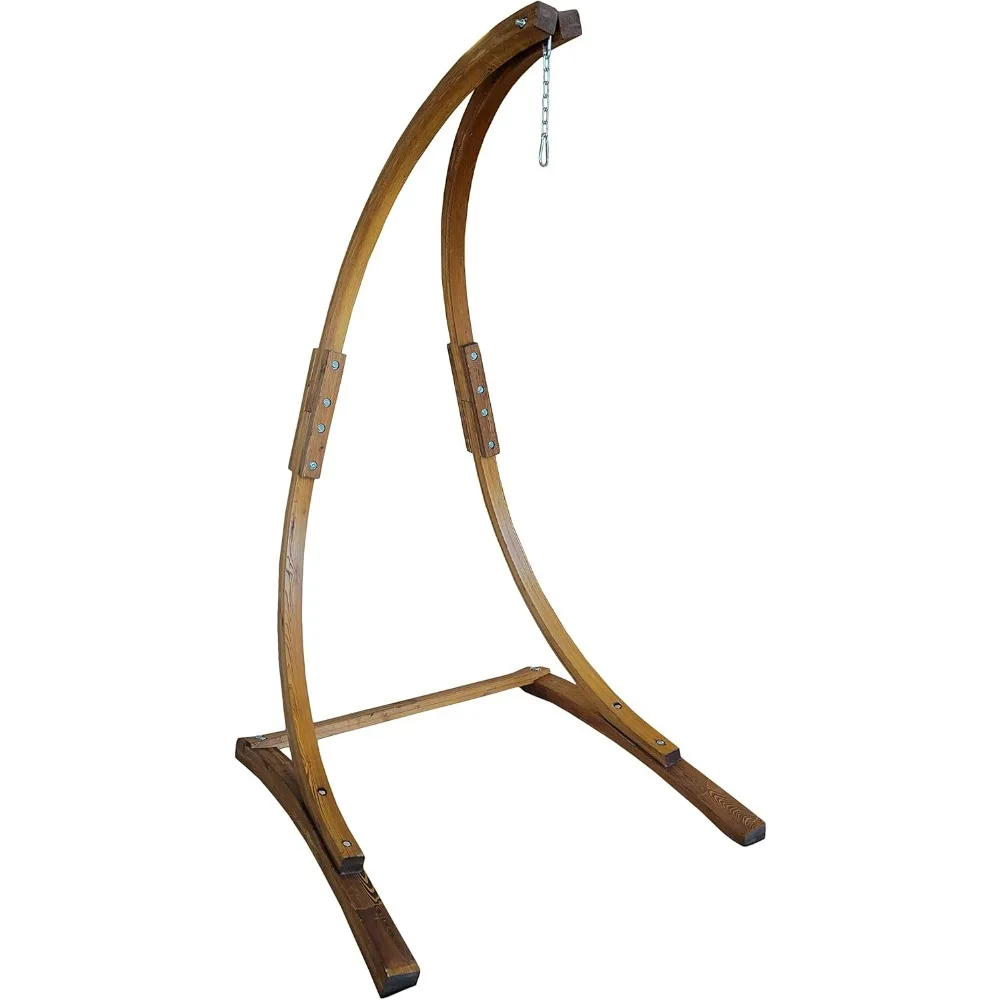
When to Store Your Hammock Chair Indoors
Sometimes the best protection is temporary removal from harsh conditions. Understanding when to bring your hammock chair inside prevents unnecessary damage during extreme weather.
Consider indoor storage when:
– Winds exceed 15-20 mph (24-32 km/h)
– Temperatures drop below freezing
– Heavy precipitation is forecast
– You’ll be away for extended periods
– During off-season in severe climates
Proper storage techniques include:
– Ensuring chairs are completely dry before storing
– Storing in climate-controlled areas when possible
– Using breathable covers for long-term storage
– Positioning to prevent pressure on any single component
– Avoiding direct contact with concrete floors
Quick-removal systems make temporary storage more convenient:
– Spring clips for rapid disconnection
– Swivel hooks that don’t require full unscrewing
– Stands designed with tool-free disassembly
– Dedicated storage bags that protect while stored
The convenience of easy-to-store patio swing chairs makes weather protection simpler through temporary relocation during inclement conditions.
DIY Repair Solutions for Weather Damage
Even with diligent protection, some weather damage may occur. Addressing small issues quickly prevents them from developing into larger problems requiring professional repair or replacement.
For fabric repairs:
1. Clean the damaged area thoroughly
2. For small tears, use outdoor fabric repair tape on the underside
3. For larger damage, consider fabric patches with waterproof adhesive
4. Apply seam sealer around repairs to prevent water intrusion
5. Allow full curing before use or exposure
For frame touch-ups:
1. Sand the affected area lightly
2. Clean with appropriate solvent
3. Apply matching paint or finish in thin layers
4. Protect with clear sealer after drying
5. Allow full curing time recommended by product
For hardware issues:
1. Replace any rusted or damaged hardware with stainless steel alternatives
2. Apply thread-locking compound to prevent loosening
3. Use appropriate lubricants on moving parts
4. Consider upgrading to higher-quality components in failure-prone areas
DIY repairs are most appropriate for minor damage in non-structural areas. For issues affecting weight-bearing components or extensive damage, professional repair or replacement is safer and more cost-effective long-term.
FAQs: Expert Answers to Common Weather Protection Questions
Q: What is the single most durable material for extreme weather conditions?
A: Solution-dyed acrylic fabric on powder-coated aluminum frames provides the best overall weather resistance. This combination resists UV damage, moisture, and corrosion while remaining lightweight.
Q: If I’m on a limited budget, what minimum protection should I implement?
A: Invest in a quality waterproof, breathable cover and position your hammock chair in a partially protected location. These two steps provide significant protection with minimal investment.
Q: How long should a quality hammock chair last with proper weather protection?
A: With consistent protection and maintenance, premium hammock chairs should provide 5-7 years of service in moderate climates and 3-5 years in severe conditions.
Q: Do I need different protection strategies for desert versus coastal climates?
A: Yes. Desert environments require emphasis on UV protection and preventing material drying/cracking, while coastal areas need vigilant corrosion prevention and more frequent cleaning to remove salt deposits.
Q: Can weather damage void my hammock chair warranty?
A: Many manufacturers exclude “acts of nature” from warranty coverage. Following care instructions and documenting your maintenance can help in warranty claims if damage occurs despite proper care.
Beyond Protection: Enhancing Your Hammock Chair’s Weather Performance
Once you’ve mastered basic weather protection, consider these advanced strategies to further enhance durability and enjoyment.
Accessories that improve weather resistance include:
– Removable canopies that provide on-demand shade
– Water-resistant cushion covers that can remain outdoors longer
– Quick-drying cushion inserts that prevent internal moisture problems
– Furniture feet that elevate frames above wet surfaces
Integration with other outdoor elements creates complementary protection:
– Pergolas with adjustable covers provide flexible overhead protection
– Decorative privacy screens double as wind barriers
– Outdoor rugs under stands prevent moisture wicking from ground
– Landscaping choices that provide natural shade and wind breaks
The future of weather-resistant outdoor furniture is moving toward:
– Smart materials that respond to environmental conditions
– Modular designs allowing quick removal of vulnerable components
– Composite materials combining natural aesthetics with synthetic durability
– Integrated protection systems that eliminate the need for separate covers
At Outside Luxe, we continuously evaluate new materials and technologies to offer hammock chairs that balance immediate comfort with long-term durability in challenging weather conditions.
By implementing a comprehensive weather protection strategy, your patio hammock chair will remain beautiful, comfortable, and structurally sound for years to come—making it a true investment in outdoor living rather than a temporary addition to your space.

